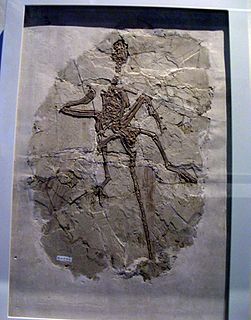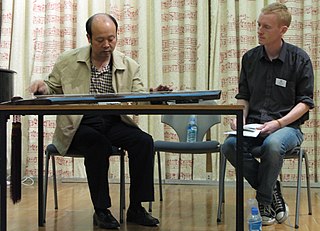
Hemiphyllodactylus is a genus of geckos ranging from India and China southward to Southeast Asia and Oceania. Species of Hemiphyllodactylus are commonly known as half leaf-fingered geckos. Many species are known as dwarf geckos or slender geckos.

The Rhodobacteraceae are a family of proteobacteria in the order Rhodobacterales within the alpha subgroup. Like all proteobacteria, they are gram-negative. It contains chemoorganotrophs and photoheterotrophs bacteria. Many occur in aquatic habitats.

Amolops is a genus of true frogs native mainly to eastern and south-eastern Asia. These frogs are closely related to such genera as Huia, Meristogenys, Odorrana, Pelophylax and Rana, but still form a distinct lineage among the core radiation of true frogs. They are commonly known as "torrent frogs" after their favorite habitat - small rapid-flowing mountain and hill streams - but this name is used for many similar-looking frogs regardless of whether they are loosely related.

Jixiangornis is a genus of basal avialans from the Early Cretaceous. Like later avialans, it had no teeth, but it also had a long tail, unlike modern birds. Since teeth were still present in some more derived short-tailed avialans, Jixiangornis seems to have evolved its toothlessness independently of modern birds. The long forelimb indicates at least some aerial ability. Jixiangornis is currently known only from a single specimen, a complete but juvenile skeleton. The fossil was found in the Yixian Formation near Beipiao City, western Liaoning, China.

The family Flavobacteriaceae is composed of environmental bacteria. Most species are aerobic, while some are microaerobic to anaerobic; for example Capnocytophaga and Coenonia.
The politics of Sichuan Province in the People's Republic of China is structured in a dual party-government system like all other governing institutions in mainland China.
The politics of Hebei Province in the People's Republic of China is structured in a dual party-government system like all other governing institutions in mainland China.

The China women's national volleyball team represents the People's Republic of China in international volleyball competitions and friendly matches governed by Chinese Volleyball Association. They are one of the leading and most successful squads in women's international volleyball, having won ten championships titles in the three major international competitions of volleyball, including five World Cups, two World Championships and three Olympic titles. The current head coach is Cai Bin.

The Berothidae are a family of winged insects of the order Neuroptera. They are known commonly as the beaded lacewings. The family was first named by Anton Handlirsch in 1906.
The Haifanggou Formation is a fossil-bearing rock deposit located near Daohugou village of Ningcheng County, in Inner Mongolia, northeastern China.
Camptodontornis is an extinct genus of enantiornithine bird which existed in what is now Chaoyang in Liaoning Province, China during the early Cretaceous period. It is known from a well-preserved skeleton including a skull found in the Jiufotang Formation of Liaoning Province. Its original generic name was "Camptodontus" ; it was named by Li Li, En-pu Gong, Li-dong Zhang, Ya-jun Yang and Lian-hai Hou in 2010. However, the name had previously been used for a genus of beetle. The type species is "Camptodontus" yangi. Demirjian (2019) coined a replacement generic name Camptodontornis. The status of C. yangi as a distinct species is disputed, with Wang et al. (2015) considering it to be a probable synonym of Longipteryx chaoyangensis.

Austrodyptornithes is a clade of birds that include the orders Sphenisciformes (penguins) and Procellariiformes. A 2014 analysis of whole genomes of 48 representative bird species concluded that penguins are the sister group of Procellariiformes, from which they diverged about 60 million years ago.

Nudix hydrolase 15 is a protein that in humans is encoded by the NUDT15 gene.
Zhang Hu was a Chinese poet of the mid-Tang dynasty. His courtesy name was Chengji.

The Shu School of Qin Music (蜀派古琴) refers to the modern guqin regional performance style tradition and lineage begun in the mid-19th century by its founder, Zhang Kongshan. The "Shu" name derives from the main base of operations at the time, namely the Sichuan region of China. Today, the Shu School has many branches and lineages, most of which trace their foundation to Zhang Kongshan, though the term is equally applied to Sichuan-based players in general.
Lake Tengger is a paleolake in China. It formed within the Tengger Desert during the Pleistocene and in reduced form during the Holocene as well. It is not certain when it existed.
Bat coronavirus RaTG13 is a SARS-like betacoronavirus that infects the horseshoe bat Rhinolophus affinis. It was discovered in 2013 in bat droppings from a mining cave near the town of Tongguan in Mojiang county in Yunnan, China. It is the closest known relative of SARS-CoV-2, the virus that causes COVID-19, sharing 96.1% nucleotide similarity. Preprint from September 2021 suggested even a closer match with a strain of coronavirus found in bats in Laos.
Mesochrysopidae is an extinct family of lacewings known from the Jurassic and Cretaceous periods. They are considered to be closely related to green lacewings of the family Chrysopidae. The family are also alternatively considered a paraphyletic grade leading up to crown Chrysopidae.











